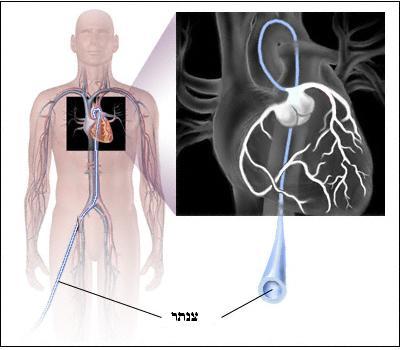An enzyme mounted on the "stent" releases a drug when a pre-drug compound reaches it
The Technion

The Technion researchers offer a new approach to prevent re-occlusion in the arteries after catheterization and implantation of a stent ("stent"). For this purpose, they put on the "stent" an enzyme that is actually a "factory" for the drug and it produces a drug locally when the necessary raw material reaches it in a "pre-drug" state.
"The catheterization injures the blood vessels," explains Professor Noah Lotan from the Faculty of Biomedical Engineering. "The new tissue that forms around the wound may form a new blockage, so the surgeon puts a 'stent' (support) mounted on a balloon and is, usually, in the form of a metal mesh. When the balloon deflates, the mesh stays close to the blood vessel walls, where it should prevent re-clogging. The initial problem - after about a week since the implantation of the stent, a blood clot forms at the site. There is a solution to this problem by giving an anticoagulant. However, in 30%-40% of those who are catheterized, a new blockage is formed in place, despite the presence of the stent. It turned out that the reason for the development of the new narrowing is not in new deposits from the blood, as previously thought, but in the tissue growing from the blood vessel wall. Doctors treat this tissue as a cancerous tumor that must be treated by administering a drug that prevents uncontrolled growth. However, this should not be treated as a cancerous tumor in the whole body, therefore the anti-cancer drug should be directed only to the place where the 'stent' is placed. The manufacturers of the stents put the medicine on the 'stent' during its manufacture and it should be released slowly over six months. The problem is that with this approach there is no precise enough control over both the duration of the drug's release and the rate of this process."
Professor Lotan, together with Dr. Sharit Sivan and Prof. Uri Diner, present a new approach towards solving the problem. They propose to provide the patient with a certain substance, completely neutral (pre-medication), which can be swallowed for the required time and without causing any side effects. This substance becomes a medicine only when it comes into contact with a special enzyme, which is fixed on the "stent". In this way, this enzyme actually functions as a "drug factory".
"In the approach we developed, the pre-medication is an amino acid - a natural component of every protein, so it can be swallowed without any side effects," explains Professor Lotan. "In this way we enable a controlled release of the drug only in the desired place and also for the desired length of time. The patient simply stops taking the pre-medication at the end of six months, when it is clear that there is no uncontrolled growth of the tissue at the catheterization site."
The developed approach actually constitutes a very general technological platform. It can be applied for various medical problems, where for each of them a suitable pre-drug and enzyme can be used.
The Technion registered a patent for the discoveries of its researchers.
